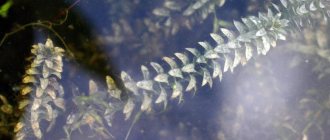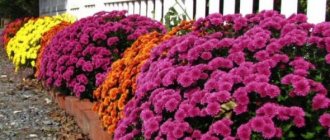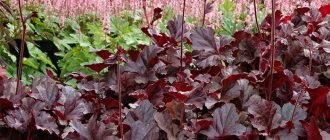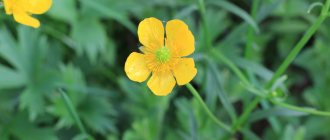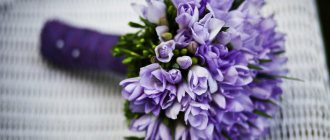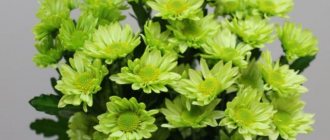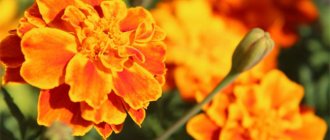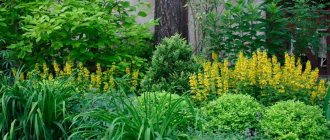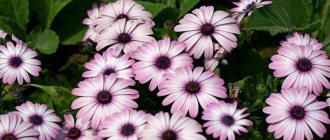Recently, it has become very fashionable among gardeners to create mini-reservoirs in their garden plots: ponds, lakes, and other waterways. It goes without saying that in this case one cannot do without coastal aquatic vegetation, because it is the main decoration of reservoirs. There are many thousands of species of plants living in water, but not all of them are suitable for growing in the middle zone. On this page you will learn the names of aquatic flowers and plants of the coastal zone, adapted to our conditions. You can also get acquainted with the description of aquatic plants and see their photographs.
Plants of the aquatic environment and coastal zone of water bodies
Calamus (ACORUS). Family Araceae.
Calamus (Amyra root) (A. calamus) is a rhizomatous perennial 50-80 cm high with straight sword-shaped leaves. Small greenish inflorescences-cobs are not interesting.
Variegatus variety has green leaves with yellowish stripes along the edges (they turn pinkish in spring).
Growing conditions. Near water, planting depth 8-20 cm.
Reproduction. By dividing the bush (in spring).
This coastal plant is used to decorate the banks of reservoirs.
Watch (MENYANTHES). A family of shift workers.
Three-leaf watch (M. trifoliata) is a perennial with a thick, long, branched rhizome, growing in stagnant water, along the muddy banks of rivers and lakes in the temperate zone of Eurasia. Blue-green trifoliate leaves on long petioles give the plant a decorative appearance. The flowers of this coastal aquatic plant are white and pink, collected in a dense raceme.
Growing conditions. Low banks of reservoirs, shallow waters.
Reproduction. Sections of rhizomes with a renewal bud (at the end of summer). Planting density - 12 pcs. per 1 m2.
Used to decorate ponds.
Mertensia (MERTENSIA). Borage family.
Rhizomatous perennials, mainly growing along the seashores in North America and the Far East, are also found in the middle zone. The leaves are grayish-blue, lanceolate; inflorescence - a curl of bright blue flowers.
Types and varieties:
Mertensia ciliata (M. ciliata) - height 4050 cm.
Sea mertensia (M. maritima) - 10-15 cm high.
Virginia Mertensia (M. virginica) - 40 cm high.
Growing conditions. Moist, poor sandy soils in sunny locations.
Reproduction. By seeds (sowing in spring), dividing the bush (in spring). Juveniles, divide and replant in the 3rd-4th year. Planting density - 25 pcs. per 1 m2.
Sedge (CAREX). The sedge family.
Perennial rhizomatous herbs with dense, narrow, like cereal, leaves and thin spikelets. Numerous species are widely distributed throughout the world, but only a few are used as ornamental plants.
Types and varieties:
Buchanan sedge (C. buchananii) - 60 cm high, brownish leaves.
Morrow sedge (C. morrowii), variety “Variegata” - 50 cm high.
Rust-spotted (C. siderosticta) and hairy (C. pillosa) are forest sedges.
Drooping sedge (C. pendula) - up to 100 cm high, semi-aquatic.
Growing conditions. This coastal plant of water bodies is planted in areas with any soil and sufficient moisture. Forest sedge species prefer shady areas.
Reproduction. By seeds (sowing in spring) and dividing the bush (late summer). Planting density - 9-12 pcs. per 1 m2.
Cattail (TYPHA). Cattail family.
This is coastal aquatic vegetation with a creeping thick rhizome, 100-200 cm high. The leaves are broadly linear at the base of the stem. These are plants that grow near water along the banks of rivers and other bodies of water in the temperate zone of Eurasia, often forming thickets.
Types and varieties:
Broadleaf cattail (T. latijoiia) - height 100-150 cm; Narrow-leaved cattail (T. angustifolia) - height 100-150 cm.
Growing conditions. Wet shores of reservoirs.
Reproduction. By dividing the bush (in spring and late summer).
Huttinia (HOUTTUYNIA). Family Saururidae.
Huttinia heart-shaped (H. cordata) is a new plant for central Russia, but it is worthy of the difficulties associated with its cultivation. The species itself, which came into cultivation from the coastal meadows of the south of the Far East, is rarely grown.
The varieties of interest are: “Chameleon” - with leaves along the edges of which white, yellow, and red spots are scattered, and “Plena” - with double flowers.
The plant is creeping, quickly forms a thicket 20-50 cm high. It blooms rarely and not abundantly in central Russia.
Growing conditions. Semi-shaded banks of reservoirs with clay soils.
Reproduction. In spring, a piece of rhizome with a renewal bud. Planting density - 16 pcs. per 1 m2.
Waterfoil (HYDROPHYLLUM). Waterfolia family.
Long-rhizome perennials from the moist forests and grasslands of eastern North America with large lobed leaves and a fluffy, branched inflorescence of pink-purple flowers. Adapted to Russian conditions, where it is planted along the banks of reservoirs.
Types and varieties:
Canadian waterfoil (H. canadense) - rounded-lobed leaf; Virginia waterfoil (H. virginianum) has an elongated lobed leaf.
Growing conditions. This coastal plant prefers semi-shaded to shady locations with moist, rich soils.
Reproduction. Sections of rhizomes with a renewal bud at the end of summer. Planting density - 16 pcs. per 1 m2.
Spleen (CHRYSOSPLENIUM). Saxifraga family.
Alternate leaf spleen (Ch. alternifolium) is a perennial with a fleshy stem, height 5-15 cm, leaves in the basal rosette are light green, thickened, rounded-beam-shaped; the inflorescence is flat, corymbose, the flowers are golden-green. They form thickets in damp, shady places.
Growing conditions. Semi-shaded places near reservoirs, in depressions of the relief.
Reproduction. By seeds (sowing in autumn), dividing the bush (in summer). It grows weed on wet soils. Planting density - 36 pcs. per 1 m2.
Use only in areas that imitate natural thickets. Unstable decorative, good only in early spring.
Hybrid water lily (Nymphaea)
No other plant can compare with the beauty of nymphs or water lilies - one of the most beautiful aquatic plants. These are white wild water lilies from natural reservoirs, and varietal nymphs with large, 15-20 cm in diameter flowers of a wide variety of colors: white, pink, yellow, crimson. They bloom in June-September.
Water lilies appeared on sale several years ago, but they are still not inferior to anyone in the beauty of aquatic plants. Water lilies give the pond a touching, nostalgic flair and fit perfectly into the design of a dacha in both a romantic and art nouveau style.
Hybrid water lily
Features of cultivation
Recommended for the deep-water zone of a reservoir, when planting large plants at a depth of 50 cm or more, small ones - from 20 cm, preferably in a thick layer of organic silt or on fertile heavy clay soil.
This is interesting
In ancient times, blue nymphea flowers, called the Egyptian blue rose, decorated the halls of rulers, places of worship and homes in the land of the pharaohs. In Ancient Greece, the water lily flower was a symbol of beauty and eloquence. There is a legend about nymphs who turned into a white water lily flower and lured travelers to the bottom.
Water lilies in a pond
Among the Slavs, the water lily was endowed with mystical and healing powers. It was called the overcoming herb and was believed to be able to overcome all evil spirits and illnesses. In addition, she helped travelers, softened the hearts of cruel beauties, and endowed them with talents.
You can also read about the hybrid water lily on the website in the article Late flowering in a pond.
Coastal aquatic vegetation: plants living in water and on the shore
This section presents photos of aquatic plants with names and descriptions, suitable for growing in shallow waters of fresh water bodies and along their banks.
Whitewing (CALLA). Family Araceae.
Swamp whitewing (C. palustris) is a rhizomatous perennial that grows along the banks of reservoirs in the temperate zone of the Northern Hemisphere. Leaves are basal on long petioles, heart-shaped, rounded. The flowers are collected in an inflorescence-cob, covered with a white ovoid veil.
Growing conditions. This light- and moisture-loving plant is grown both in shallow waters of fresh water bodies and along their banks.
Reproduction. Propagated by seeds, sowing in wet soil immediately after collection. It is best to divide the rhizomes at the end of summer. Planting density - 7 pcs. per 1 m2.
Look at the photo: this aquatic plant provides an early spring effect as part of mixed groups with summer-flowering plants; interesting in rock gardens, in flower beds, where annuals are then planted.
Sitnik (JUNCUS). Sitnikov family.
Perennial rhizomatous moisture-loving herbs. The leaves are grass-like, decorative capitate or paniculate inflorescences.
Types and varieties. S. acutiflorus (J. acutiflorus) - up to 100 cm high, paniculate inflorescence; With. spreading (J. effusus) - up to 150 cm high, inflorescence fascicle-paniculate; With. xiphoid (J. ensifolius) - 20-30 cm high, inflorescence capitate, dark brown; With. glaucous (J. glaucus) - 60-90 cm high, bluish leaves.
Growing conditions. Sunny shores of reservoirs at a depth of 0-5 cm.
Reproduction. Rhizome sections in spring or late summer.
Buttercup (RANUNCULUS). Ranunculaceae family.
A large genus, the species of which are widely found everywhere, but only a few of the most decorative perennials are used in culture. Among them there are also aquatic plants, but more often buttercups grow on the shores of reservoirs.
Types and varieties:
Aquatic and semi-aquatic: R. acris, variety “Multiplex”, height 50-70 cm, water depth 0-10 cm.
Water buttercup (R. aquatilis) - water depth 40-100 cm; l. long-leaved (R. lingua) - depth 0-20 cm, Grandiflora variety.”
Cappadocia buttercup (R. cappadocicus) - from the forests of the Caucasus, consistently ornamental, forms thickets.
Growing conditions. Aquatic - in reservoirs with standing water and in shallow water; l. Cappadocian - in the shade.
Reproduction. By dividing the bush (in spring). Planting density - 25 pcs. per 1 m2.
Fed up (CYPERUS). The sedge family.
Long grass (C. longus) is a long-rhizomatous perennial that grows along the banks and in shallow waters (depth up to 20 cm) of standing and slowly flowing waters. If we talk about which aquatic plants are most common in central Russia, then the seaweed is mentioned most often. Its tall (60-120 cm) leafy stem rises above the water, bearing an openwork umbrella with long (10-40 cm) “rays” carrying a bunch of small brownish spikelets. Consistently decorative. Forms loose thickets.
Growing conditions. Reservoirs.
Reproduction. Sections of rhizomes with a renewal bud (at the end of summer).
Reed (PHRAGMITES). Poa family (grasses).
Common reed (P. communis) is a long-rhizome tall grass (150-200 cm), forming thickets along the banks and shallow waters of reservoirs.
Growing conditions. Sunny and semi-shaded areas with wet soils, low banks of reservoirs. This coastal plant can also be grown in shallow water.
Reproduction. Sections of rhizomes with a renewal bud (spring, late summer). Planting density - 5 pcs. per 1 m2.
Small duckweed and edible arrowhead
Duckweed is a monoecious plant , very small in size, floating on the surface in huge clusters. It has no divisions into stems and leaves. The body is completely covered with a plate-like shape and is green in color. There is one dense root and shoot of the same shape as the flower itself. It has one or five veins with air cavities, some are capable of having pigment cells.
They almost never bloom. Contains various small inflorescences. There are two stamens and one pistil. This suggests that the flower mainly consists of male inflorescences. The inflorescence itself is represented by a leaf appendage. The fruit looks like a sac that has outgrowths and a keel. It allows the plant to float calmly on the surface of the water. Duckweed is excellent food for turtles and geese, as well as small fish.
Arrowhead is a perennial plant that has more than 40 species. Grows entirely in water. Consists of a short stem 20−120 centimeters in size. Has air-bearing tissue. The leaves are of various shapes, mostly resembling arrows. The flowers are collected with a brush and have a diameter of one meter. There is also a green calyx and a white base. From May to August is the flowering period. The fruit is an achene with a nose. The seeds themselves spread using currents. The tubers are used as food. They are eaten by both people and animals.
Perennial aquatic flowers and ornamental herbaceous plants
Aquatic flowers and plants are a real decoration of ponds. But herbaceous aquatic plants are no less interesting, attracting attention with their rich greenery.
Arrow leaf (SAGITTARIA). Chastukhov family.
These are aquatic flowers, which are rhizomatous perennials, rooted at a depth of 10-50 cm. The leaves are dark green, shiny, dense. Flowers in inflorescence are a sparse raceme.
Types and varieties:
Broad-leaved arrowhead (S. LatifoLia) - height 50-70 cm, flowers with a yellow center; arrowhead arrowhead (S. sagittifoLia) - height 30-50 cm, flowers with a red center.
Growing conditions. Planting in reservoirs with standing or slowly flowing water to a depth of 10-50 cm.
Reproduction. By seeds (sowing in spring in containers and then planting in water).
Chastukha (ALISMA). Chastukha family.
A perennial aquatic plant with beautiful ribbed leaves on long petioles. They bloom all summer. The flowers are small, with three petals, arranged in whorls.
Types and varieties:
Chastukha plantain (A. plantagoaquatica) - pink flowers; small-flowered chastuha (A. parviflora) - white flowers.
Growing conditions. These plants live in an aquatic environment in the shallow waters of natural reservoirs. Planting depth 5-10 cm.
Reproduction. By dividing the bush (summer) or seeds (spring).
Broadleaf cattail
Broadleaf cattail is a plant that is easily recognized by its brownish-brown ears or inflorescences. It is also a perennial plant . Has a full mixed inflorescence. It grows mainly in wetlands. At the moment when ripening begins, it is able to spray its seeds throughout the area.
In water, young plants are firmly attached. Their root system is often visible. The stem can reach three meters in length. The rhizome has a dense, thick structure and is capable of growing over quite a long distance. The leaves are gray with a green tint. The flowers are unisexual, have a spadix that consists of 2-3 parts. Their length can reach 13-14 centimeters, and their width is 3 centimeters. In August it fully ripens and spreads its seeds.
Wetland plants growing near water
Marigold (CALTHA). Ranunculaceae family.
Marigold (C. palustris) is a perennial wetland plant with a short rhizome. The basal leaves are entire, round, bright green, shiny. The flowers are bright yellow, as if varnished. Abundant seed production in July-August. More often in gardens, the double form of this species is grown - marsh marigold "Multiplex".
Growing conditions. Sunny places with clay soils that retain water well.
Reproduction. By dividing the bush at the end of summer. The bush grows slowly, so division is carried out after 6-7 years. It is propagated by freshly collected seeds; they germinate the following spring, but the seedlings bloom in the 5-6th year. Planting density - 9 pcs. per 1 m2.
An excellent plant for decorating the banks of reservoirs and in “natural garden” flower beds that imitate wet meadows. Here marigold is planted together with loosestrife, drooping sedge, knotweed, crayfish, etc.
Reed (SCIRPUS). The sedge family.
Lake reed (S. lacustris) is a perennial with a thick creeping rhizome 100-120 cm high, growing along the banks of reservoirs in Europe and North America. The inflorescence is paniculate, the leaves are subulate.
Growing conditions. Wet, low places along the banks of reservoirs.
Reproduction. By dividing the bush (in spring and late summer), by seeds (sowing before winter).
Swamp flower (NYMPHOIDES). A family of shift workers.
Cottonweed (N. peltata) is an aquatic perennial with a rhizome, round shiny leaves on long petioles and numerous flowers emerging from the leaf axil. The name of this aquatic plant speaks for itself - it prefers exclusively marshy areas.
Growing conditions. Reservoirs with standing or slowly flowing water, depth 20-100 cm.
Reproduction. By seeds (into the ground under water), by dividing the bush.
Used when decorating reservoirs.
Design of ponds in the country
Many factors influence the creation of a colorful landscape around the water surface. It is necessary to take into account the composition of the soil, the topography of the place, the illumination of the area, and the compatibility of plants.
- We choose a place. Water crops prefer moist soils that do not dry out for a long time after rains. Therefore, it is better to choose a place for a reservoir where layers of clay or loam lie in the ground at a shallow depth. Low-lying areas of land are well suited for a pond.
- We provide lighting. Air humidity near the water needs to be high, so constant sunlight should not quickly dry out the soil. This is also important so that the plantings do not grow too much and the water surface does not “bloom.”
- Protect from plant debris. Tall deciduous trees should not be close to water. Fallen leaves, twigs broken in the wind, and seeds litter water bodies. Cleaning the surface takes a lot of time and labor.
- We think over the design. The design style should support the overall decoration of the entire site. It must “submit” to the general style of the local area and be in harmony with it.
Floating aquatic flowering and herbaceous plants
Watercolor (HYDROCHARIS). Family of watercolors.
Common waterweed (H. morsusranae) is a floating aquatic plant of standing or slowly flowing waters with developed shoots and rounded dense dark green leaves in rosettes on long petioles and white 15-30 cm, flowering all summer.
Growing conditions. Aquatic plant.
Reproduction. Seeds, rosettes of leaves.
Used in ponds.
Water chestnut (TRAPA). Water chestnut family.
The common water chestnut (T. natans) is an annual aquatic herbaceous plant that grows in slow-moving waters. There are thread-like submerged leaves and a beautiful rosette of floating leaves.
Growing conditions . Reservoirs.
Reproduction. Place seeds (nuts) on the bottom of the reservoir in the fall.
Used to decorate natural reservoirs.
Egg pod (NUPHAR). The water lily family.
Yellow egg capsule (N. iutea) is a perennial aquatic flowering plant with a fleshy underwater rhizome and wide, dense, leathery leaves above the water. A large waxy flower appears above them in June. The name of these aquatic flowers is quite justified - the flower really resembles a water capsule. Widely distributed in natural reservoirs of the temperate zone.
Growing conditions. Ponds, lakes with standing or slowly flowing water, at a depth of 30-80 cm.
Reproduction. Seeds (sow freshly harvested), sections of rhizome with renewal bud (at the end of summer). Planting density - 12 pcs. per 1 m2.
Waterlily (NYMPHAEA). The water lily family.
The genus includes about 30 species of aquatic plants growing in water bodies of temperate and tropical zones.
Types and varieties. In the reservoirs of central Russia, white flowering plant (N. alba) grows - a rhizomatous perennial with round, unequal leaves on long petioles floating on the surface of the water. The leaves are green above, reddish below.
Look at the photo of these aquatic flowers - they are all large, mostly white. They have a pronounced aroma.
There are numerous varieties of N. xhybrida:
"Gladstoniana", "Fire Opal"
“Hollandia”, “Rose Arey”, etc.
Growing conditions. These aquatic flowering plants prefer ponds with standing or slowly flowing water and grow at a depth of 30-100 cm.
Reproduction. Seeds (in the fall to the bottom of the reservoir), sections of rhizomes with a renewal bud (at the end of summer in the soil of the reservoir). Planting density - 12 pcs. per 1 m2.
These ornamental aquatic plants are used to decorate ponds.
Turcha
This oxygenator differs from many representatives of the group in its ability to bloom brightly. Turchi flowers appear on peduncles that grow up to 20-25 cm in height and rise above the surface of the water surface of the pond. White or pale purple flowers are at the very top of the peduncles.
The feathery leaves of the plant are bright green in color. In the fall they die off, and the turkish buds safely overwinter in the pond. The plant can be propagated by cuttings, which is best done in the summer.
Other oxygenating plants for a garden pond: swampweed, water buttercup, tillea, urut, hara, telores.
Remember that oxygenating plants are very useful for a pond, therefore, when organizing a pond on your site, do not forget to plant elodea, hornwort or water moss in it.
Iris pseudacorus (Iris pseudacorus)
A very spectacular aquatic plant from the iris or iris family, quickly forming groups of lush greenery. During the flowering period, it brings its sunny, joyful chords, proclaiming the triumph of life. It grows up to 90 cm high, on one rhizome there are 12-15 bright yellow flowers that bloom in late May - July. Sword-shaped leaves up to 120 cm long are decorative throughout the summer.
Iris calamus or swamp. Photo from econet.ru
Features of cultivation
Planted in shallow water. Control of the spread of rhizomes is necessary. It is better to plant it in a container and annually remove shoots that grow to the sides. At the end of summer, all leaves are cut off so as not to litter the banks and bottom of the reservoir.
This is interesting
In the Middle Ages, the iris became a Christian symbol, personifying the suffering of the Virgin Mary, and at the turn of the 19th-20th centuries. - one of the flowers of the Art Nouveau style.
Cattail (Typha)
All cattails are beautiful background perennials. They are recommended for creating spectacular thickets in large bodies of water, and in small ones they are planted in small groups or individually. Cattails look harmonious in the ponds of landscape-style dachas. Their dense, dark brown inflorescences-cobs with a velvety surface bloom in June-August.
Cattail angustifolia
Features of cultivation
The minimum depth for placing plants in a reservoir is 7-12 cm. Control of distribution is required; It is better to plant in a container. In this case, excess rhizomes should be removed to prevent overgrowth.
This is interesting
Surely many of you know the cattail called “reed”. However, true reed is a completely different plant from the sedge family, with wide panicles at the ends of long stems. You will read about it below. Why this happened is not known for certain.
